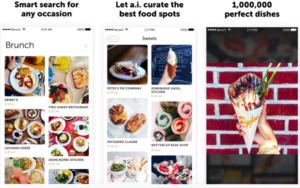Want smarter insights in your inbox? Sign up for our weekly newsletters to get only what matters to enterprise AI, data, and security leaders. Subscribe Now
After Prisma, the much-hyped mobile app that instantly transforms pictures into artwork, and Artisto, a similar app for videos, Russian programmers are affirming their particular talent in developing technologies inspired by neural networks.
This time, this approach is being applied to food recommendations with ‘Borsch,’ a new mobile service launched over the past weeks in nine cities in the USA — including New York, Chicago, Los Angeles, San Francisco, Austin, Houston and Phoenix, — Germany and Russia.
The ‘Borsch’ iOS app allows users to visually choose their next meal by scrolling through a grid of locally-sourced pictures which the underlying neural network has identified as particularly appealing. After clicking on a picture or typing in a food-related search query, users receive information from nearby places serving food that looks “just like that.”
The system uses publicly available, user-generated food images, including geotagged Instagram posts and review websites. The app has a small built-in neural network that can work offline to determine whether the things the phone’s camera is pointed at are food or not. Thus, only meaningful pictures are uploaded to the main dataset.
AI Scaling Hits Its Limits
Power caps, rising token costs, and inference delays are reshaping enterprise AI. Join our exclusive salon to discover how top teams are:
- Turning energy into a strategic advantage
- Architecting efficient inference for real throughput gains
- Unlocking competitive ROI with sustainable AI systems
Secure your spot to stay ahead: https://bit.ly/4mwGngO
During this summer the app’s neural network analyzed more than 10 million photos from open resources like Instagram, the company’s press service told East-West Digital News. Almost 650,000 photos in total were identified as food shots, including 13,900 pictures coming from New York, 5,065 from Berlin and 4,302 from Moscow.
Furthermore, not only does the neural network differentiate types of food, but “it also distinguishes appetizing meals from unappealing ones,” the company claims.
The machine learning process has been going on for six months now. “We are working on improving the quality of food image recognition; for example, the neural network is now learning how to differentiate dishes of sophisticated cuisine of Asia and India,” according to the company’s press service.
The Borsch developers are also working on text analysis to apprehend the emotions that users have after lunch. “If they post a burger and say ‘wow, that one was perfect,’ the neural network will add this info to their personal score.”
Another R&D goal is to show in real-time data such as the number of calories and food indexes (glycemic, insulin etc.) for each meal.
From pro-Kremlin media to mobile apps
Behind the startup is Ashot Gabrelyanov, a Russian entrepreneur who previously founded LifeNews — an influential Russian TV channel which is known for its radical pro-Kremlin coverage of domestic and international politics.
Although he lives in Brooklyn, Gabrelyanov does not define himself as an “immigrant:” “I decided to move to New York to expand our network and raise money for the startup,” he explained to East-West Digital News.
Gabrelyanov has invested $150,000 of his own money to develop the Borsch project, which he claims is the very first food discovery app to use neural networks.
The company is run by a team of eight developers from offices in Brooklyn and Moscow.
“We decided to focus on the US market first to prove that Borsch is the easiest way to find a good place to eat and see if people are using the app in the way we expected they would,” the entrepreneur told EWDN.
Borsch, which reached 1,500 installs in a week after launch without any marketing efforts, claims a 30% retention rate. “Our short-term goal is to reach 100,000 active users in the biggest US cities, to expand to more European cities, and to start generating earnings on ads,” Gabrelyanov said.
The startup also hopes to generate revenue from delivery fees (in partnership with Postmates) and from extra features available to users, such as the calorie calculator.
Previously, Gabrelyanov launched Babo, a platform that helps news outlets aggregate content from ‘citizen journalists’ using smartphones. Babo is now used by more than 1 million contributors, with a total of 2 million videos and pictures uploaded so far.
Gabrelyanov intends to apply the neural network to Babo “so that image or video topics, e.g. accidents, can be recognized – even those undescribed and untagged – to help editors in case of a breaking news.”
This post first appeared on East-West Digital News.


